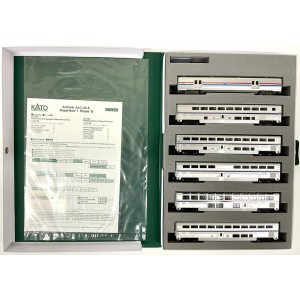Categories
- Advance Reservations
- Couplers, Trucks & Wheels
- Detailing Parts
- Freight Cars & Loads
- Locomotives
- Passenger Cars
- Signals and Lights
- Structures/Scenery & Accessories
- Track & Accessories
- Train Packs/Train Sets
- Vehicles & Figures
- DC/DCC Control
- Adhesives/Lubricants/Tools/Paints
- DVDs, Publications, Decals, Signs etc.
- Order Non Listed Item
- British/European/Japanese
- Kato Unitram & Trams
- HO/OO Scale
- Z Scale
Prototype Information:
The Superliner I fleet was built in 1979 by Pullman Standard and were based on the famous Budd built Hi-Levels operated by the Santa Fe railroad for their “El Capitan” all-coach train. 102 Superliner I coaches were built, and 48 Superliner I coach-baggage combination cars with a secure baggage hold instead of lower-level seating. For transportation of bulk items, trains would run with cars known as “Material Handling Cars” cargo carrying freight cars which would run either on the nose or tail of a consist.
The Superliner II fleet was introduced in 1990 as Amtrak’s next generation of its now ubiquitous Superliners. Visually very similar to their older cousins, the Superliner II’s have a host of mechanical and electrical improvements to their design as well as construction. One of the new styles of car introduced with this new generation of cars was the “Transition Sleeper”, or “Transition Dormitory” car. Intended to replace the aging High-Level Step Down cars, the Transition Sleeper fulfills a similar role by having high and low level diaphragms on either end of the car as well as having on-board crew accommodations.
Car Types: Today, the Phase VI (also known as Phase IVb) is the most common paint variation seen of Amtrak's equipment, and it can be seen on Amtrak Equipment of all types.
Model Features:
Fully detailed interiors can be lit with optional Interior lighting kit with LED #11-211/11-212
Finely detailed with prototype accurate painting and lettering
Free and smooth rolling trucks for maximum performance
All cars are equipped with Kato semi-automatic knuckle couplers
Includes:
- Viewliner II Baggage #61017
- Superliner II Transition Sleeper #39029
- Superliner I Sleeper #32026
- Superliner I Diner #38016
- Superliner I Lounge #33023
- Superliner I Coach #34058






